Project Report: Digital Technology Impact on Business Activities
VerifiedAdded on 2024/05/30
|31
|5776
|102
Report
AI Summary
This report explores the transformative impact of digital technology on various business activities and management practices. It is structured into three parts: a project management plan, a project logbook, and a performance review. The report examines both the positive and negative effects of digital technology on business operations, including marketing, human resources, and accounting. It employs qualitative and quantitative research methods to analyze data and provide recommendations. The project management process is critically evaluated, and the value of the research in meeting stated objectives and supporting learning and performance is reflected upon. The conclusion summarizes the key findings and insights gained from the study, highlighting the significant role of digital technology in modern business.
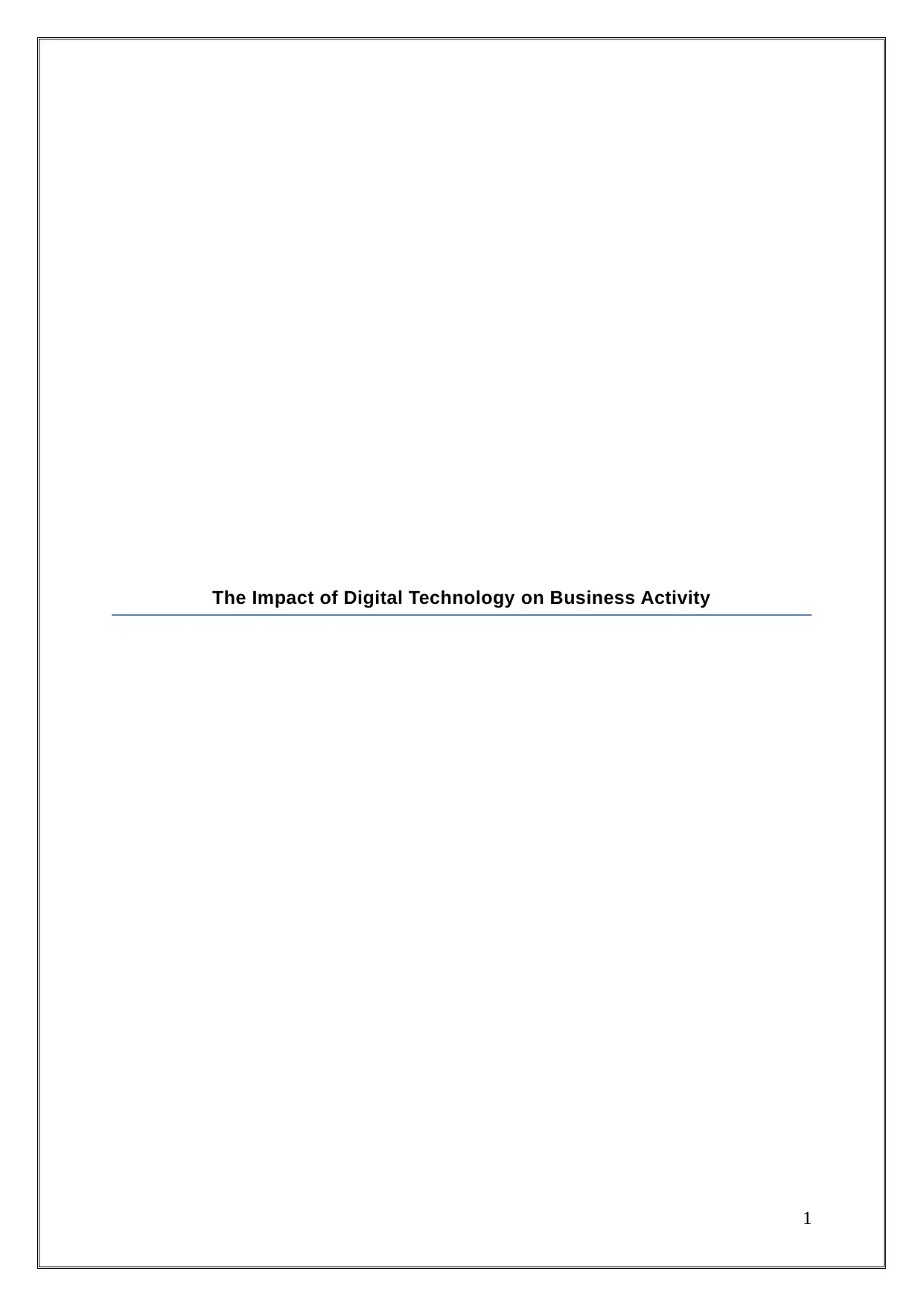
The Impact of Digital Technology on Business Activity
1
1
Paraphrase This Document
Need a fresh take? Get an instant paraphrase of this document with our AI Paraphraser
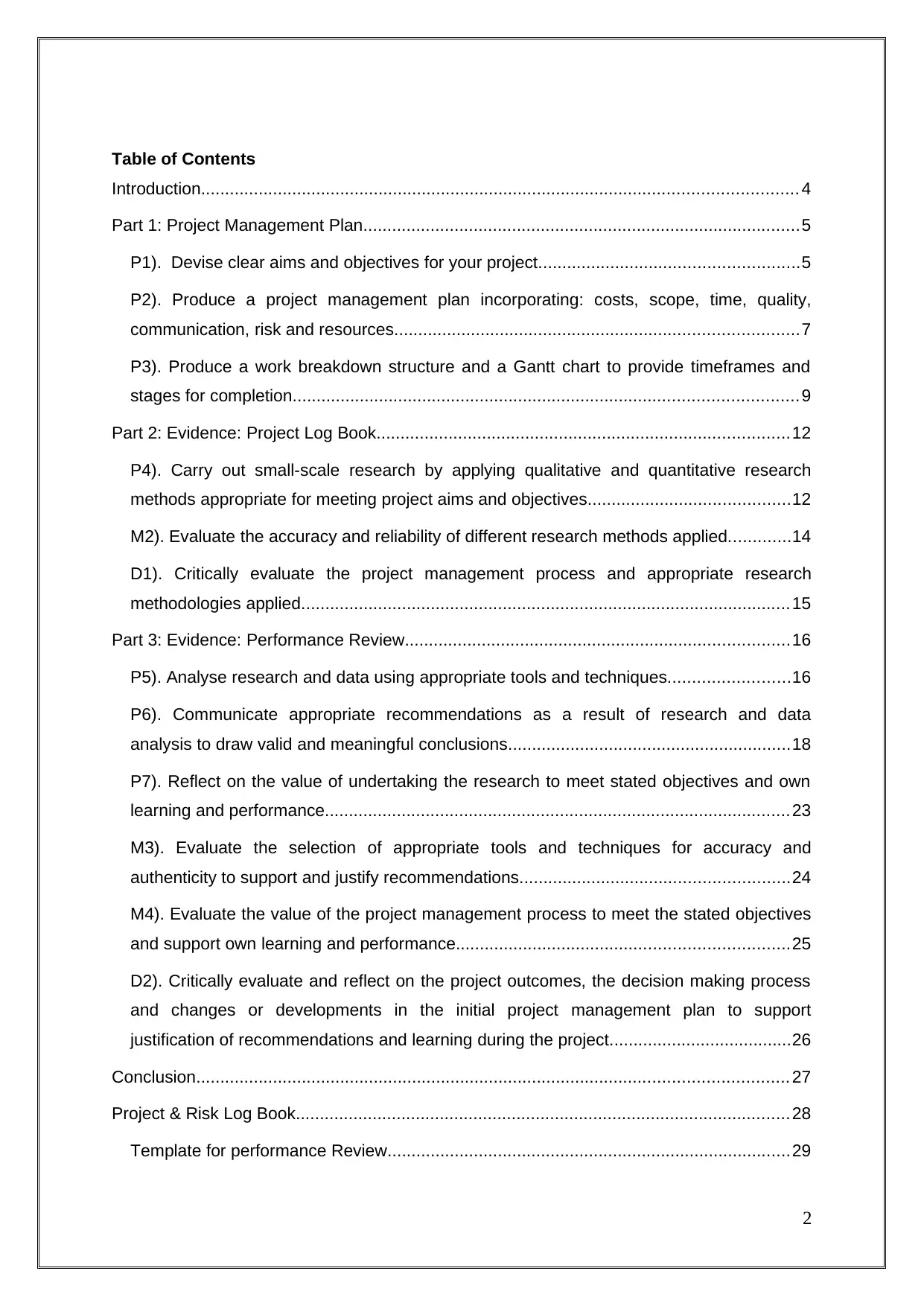
Table of Contents
Introduction............................................................................................................................ 4
Part 1: Project Management Plan...........................................................................................5
P1). Devise clear aims and objectives for your project......................................................5
P2). Produce a project management plan incorporating: costs, scope, time, quality,
communication, risk and resources....................................................................................7
P3). Produce a work breakdown structure and a Gantt chart to provide timeframes and
stages for completion.........................................................................................................9
Part 2: Evidence: Project Log Book......................................................................................12
P4). Carry out small-scale research by applying qualitative and quantitative research
methods appropriate for meeting project aims and objectives..........................................12
M2). Evaluate the accuracy and reliability of different research methods applied.............14
D1). Critically evaluate the project management process and appropriate research
methodologies applied......................................................................................................15
Part 3: Evidence: Performance Review................................................................................16
P5). Analyse research and data using appropriate tools and techniques.........................16
P6). Communicate appropriate recommendations as a result of research and data
analysis to draw valid and meaningful conclusions...........................................................18
P7). Reflect on the value of undertaking the research to meet stated objectives and own
learning and performance.................................................................................................23
M3). Evaluate the selection of appropriate tools and techniques for accuracy and
authenticity to support and justify recommendations........................................................24
M4). Evaluate the value of the project management process to meet the stated objectives
and support own learning and performance.....................................................................25
D2). Critically evaluate and reflect on the project outcomes, the decision making process
and changes or developments in the initial project management plan to support
justification of recommendations and learning during the project......................................26
Conclusion........................................................................................................................... 27
Project & Risk Log Book.......................................................................................................28
Template for performance Review....................................................................................29
2
Introduction............................................................................................................................ 4
Part 1: Project Management Plan...........................................................................................5
P1). Devise clear aims and objectives for your project......................................................5
P2). Produce a project management plan incorporating: costs, scope, time, quality,
communication, risk and resources....................................................................................7
P3). Produce a work breakdown structure and a Gantt chart to provide timeframes and
stages for completion.........................................................................................................9
Part 2: Evidence: Project Log Book......................................................................................12
P4). Carry out small-scale research by applying qualitative and quantitative research
methods appropriate for meeting project aims and objectives..........................................12
M2). Evaluate the accuracy and reliability of different research methods applied.............14
D1). Critically evaluate the project management process and appropriate research
methodologies applied......................................................................................................15
Part 3: Evidence: Performance Review................................................................................16
P5). Analyse research and data using appropriate tools and techniques.........................16
P6). Communicate appropriate recommendations as a result of research and data
analysis to draw valid and meaningful conclusions...........................................................18
P7). Reflect on the value of undertaking the research to meet stated objectives and own
learning and performance.................................................................................................23
M3). Evaluate the selection of appropriate tools and techniques for accuracy and
authenticity to support and justify recommendations........................................................24
M4). Evaluate the value of the project management process to meet the stated objectives
and support own learning and performance.....................................................................25
D2). Critically evaluate and reflect on the project outcomes, the decision making process
and changes or developments in the initial project management plan to support
justification of recommendations and learning during the project......................................26
Conclusion........................................................................................................................... 27
Project & Risk Log Book.......................................................................................................28
Template for performance Review....................................................................................29
2
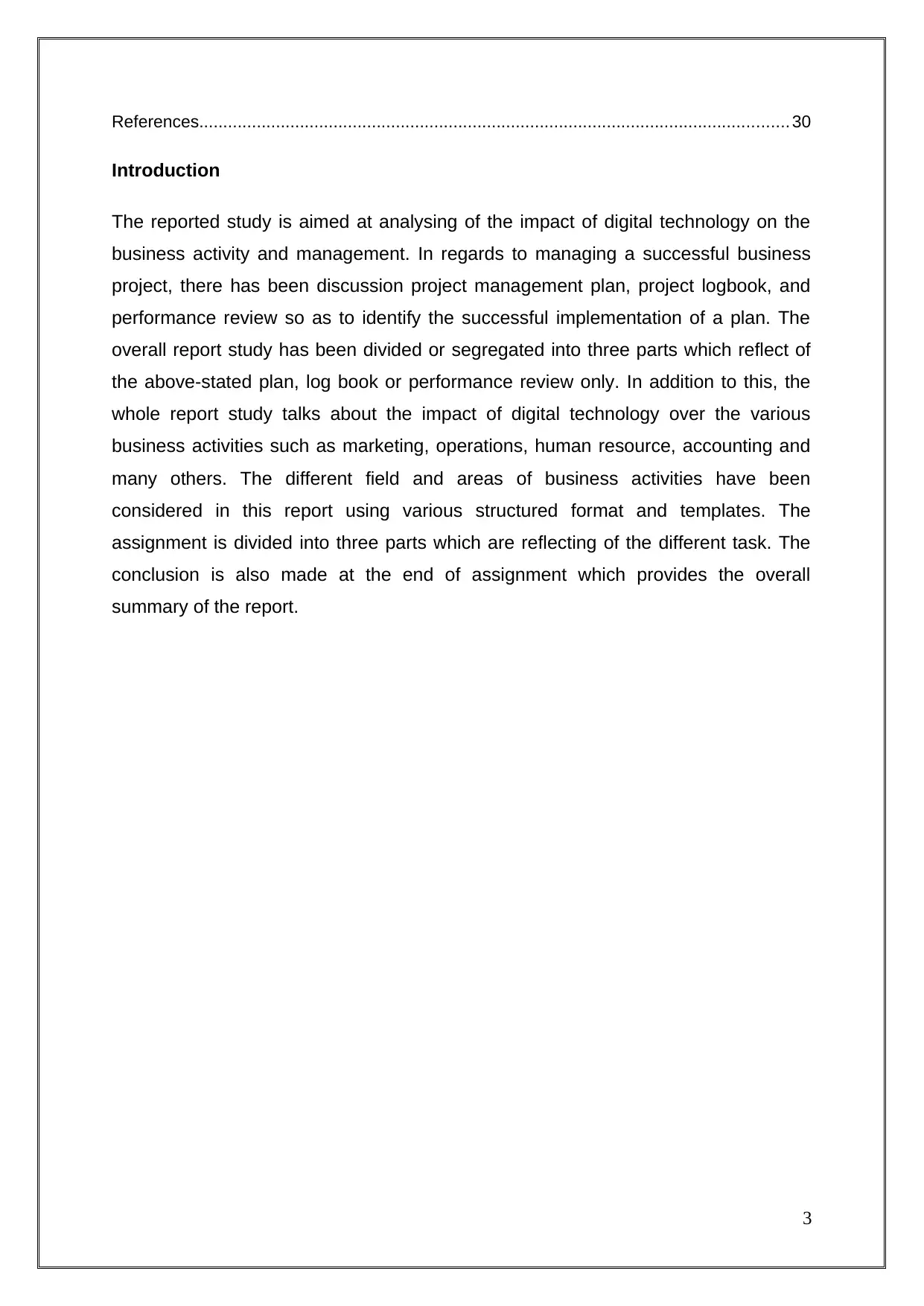
References........................................................................................................................... 30
Introduction
The reported study is aimed at analysing of the impact of digital technology on the
business activity and management. In regards to managing a successful business
project, there has been discussion project management plan, project logbook, and
performance review so as to identify the successful implementation of a plan. The
overall report study has been divided or segregated into three parts which reflect of
the above-stated plan, log book or performance review only. In addition to this, the
whole report study talks about the impact of digital technology over the various
business activities such as marketing, operations, human resource, accounting and
many others. The different field and areas of business activities have been
considered in this report using various structured format and templates. The
assignment is divided into three parts which are reflecting of the different task. The
conclusion is also made at the end of assignment which provides the overall
summary of the report.
3
Introduction
The reported study is aimed at analysing of the impact of digital technology on the
business activity and management. In regards to managing a successful business
project, there has been discussion project management plan, project logbook, and
performance review so as to identify the successful implementation of a plan. The
overall report study has been divided or segregated into three parts which reflect of
the above-stated plan, log book or performance review only. In addition to this, the
whole report study talks about the impact of digital technology over the various
business activities such as marketing, operations, human resource, accounting and
many others. The different field and areas of business activities have been
considered in this report using various structured format and templates. The
assignment is divided into three parts which are reflecting of the different task. The
conclusion is also made at the end of assignment which provides the overall
summary of the report.
3
⊘ This is a preview!⊘
Do you want full access?
Subscribe today to unlock all pages.

Trusted by 1+ million students worldwide
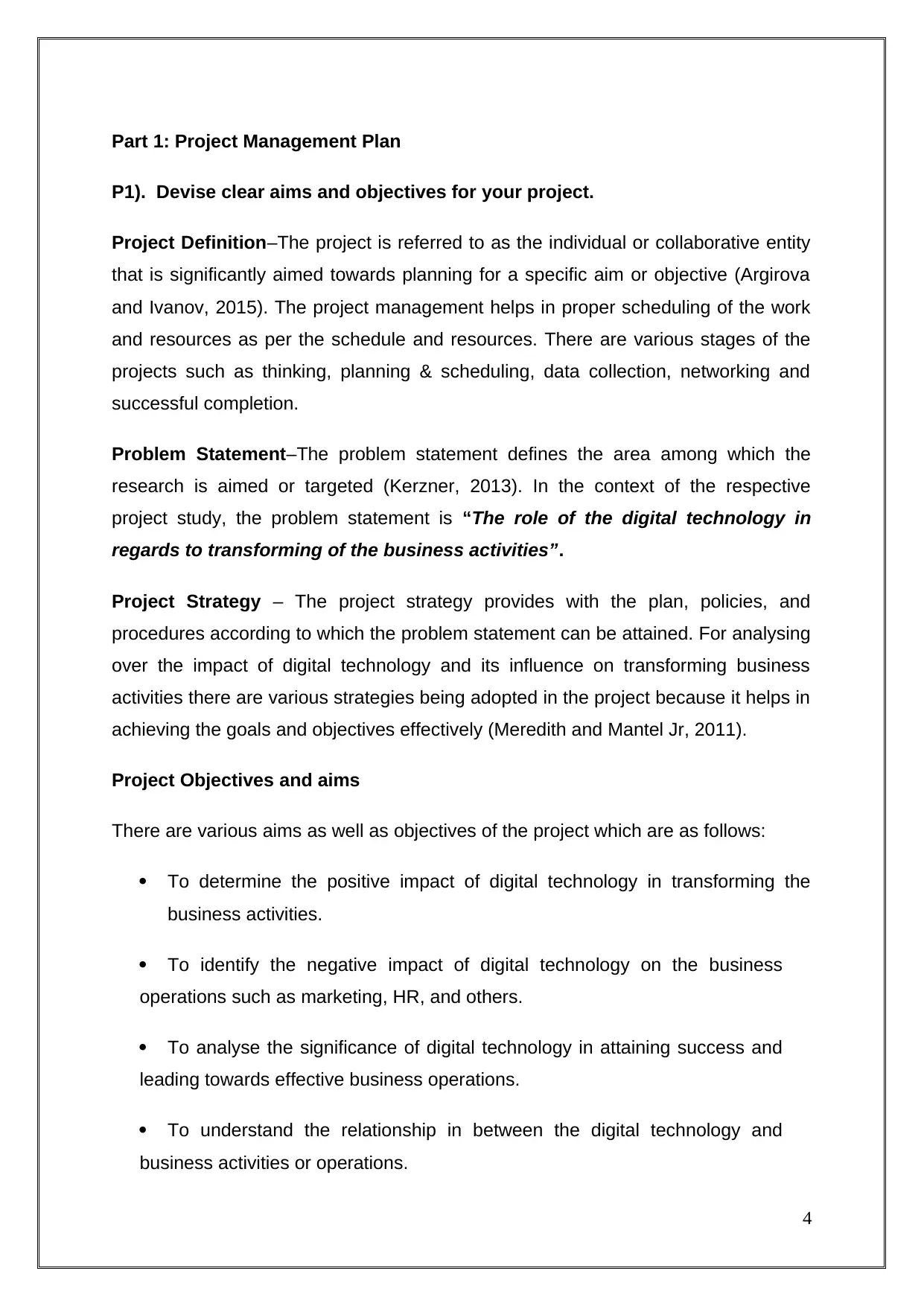
Part 1: Project Management Plan
P1). Devise clear aims and objectives for your project.
Project Definition–The project is referred to as the individual or collaborative entity
that is significantly aimed towards planning for a specific aim or objective (Argirova
and Ivanov, 2015). The project management helps in proper scheduling of the work
and resources as per the schedule and resources. There are various stages of the
projects such as thinking, planning & scheduling, data collection, networking and
successful completion.
Problem Statement–The problem statement defines the area among which the
research is aimed or targeted (Kerzner, 2013). In the context of the respective
project study, the problem statement is “The role of the digital technology in
regards to transforming of the business activities”.
Project Strategy – The project strategy provides with the plan, policies, and
procedures according to which the problem statement can be attained. For analysing
over the impact of digital technology and its influence on transforming business
activities there are various strategies being adopted in the project because it helps in
achieving the goals and objectives effectively (Meredith and Mantel Jr, 2011).
Project Objectives and aims
There are various aims as well as objectives of the project which are as follows:
To determine the positive impact of digital technology in transforming the
business activities.
To identify the negative impact of digital technology on the business
operations such as marketing, HR, and others.
To analyse the significance of digital technology in attaining success and
leading towards effective business operations.
To understand the relationship in between the digital technology and
business activities or operations.
4
P1). Devise clear aims and objectives for your project.
Project Definition–The project is referred to as the individual or collaborative entity
that is significantly aimed towards planning for a specific aim or objective (Argirova
and Ivanov, 2015). The project management helps in proper scheduling of the work
and resources as per the schedule and resources. There are various stages of the
projects such as thinking, planning & scheduling, data collection, networking and
successful completion.
Problem Statement–The problem statement defines the area among which the
research is aimed or targeted (Kerzner, 2013). In the context of the respective
project study, the problem statement is “The role of the digital technology in
regards to transforming of the business activities”.
Project Strategy – The project strategy provides with the plan, policies, and
procedures according to which the problem statement can be attained. For analysing
over the impact of digital technology and its influence on transforming business
activities there are various strategies being adopted in the project because it helps in
achieving the goals and objectives effectively (Meredith and Mantel Jr, 2011).
Project Objectives and aims
There are various aims as well as objectives of the project which are as follows:
To determine the positive impact of digital technology in transforming the
business activities.
To identify the negative impact of digital technology on the business
operations such as marketing, HR, and others.
To analyse the significance of digital technology in attaining success and
leading towards effective business operations.
To understand the relationship in between the digital technology and
business activities or operations.
4
Paraphrase This Document
Need a fresh take? Get an instant paraphrase of this document with our AI Paraphraser
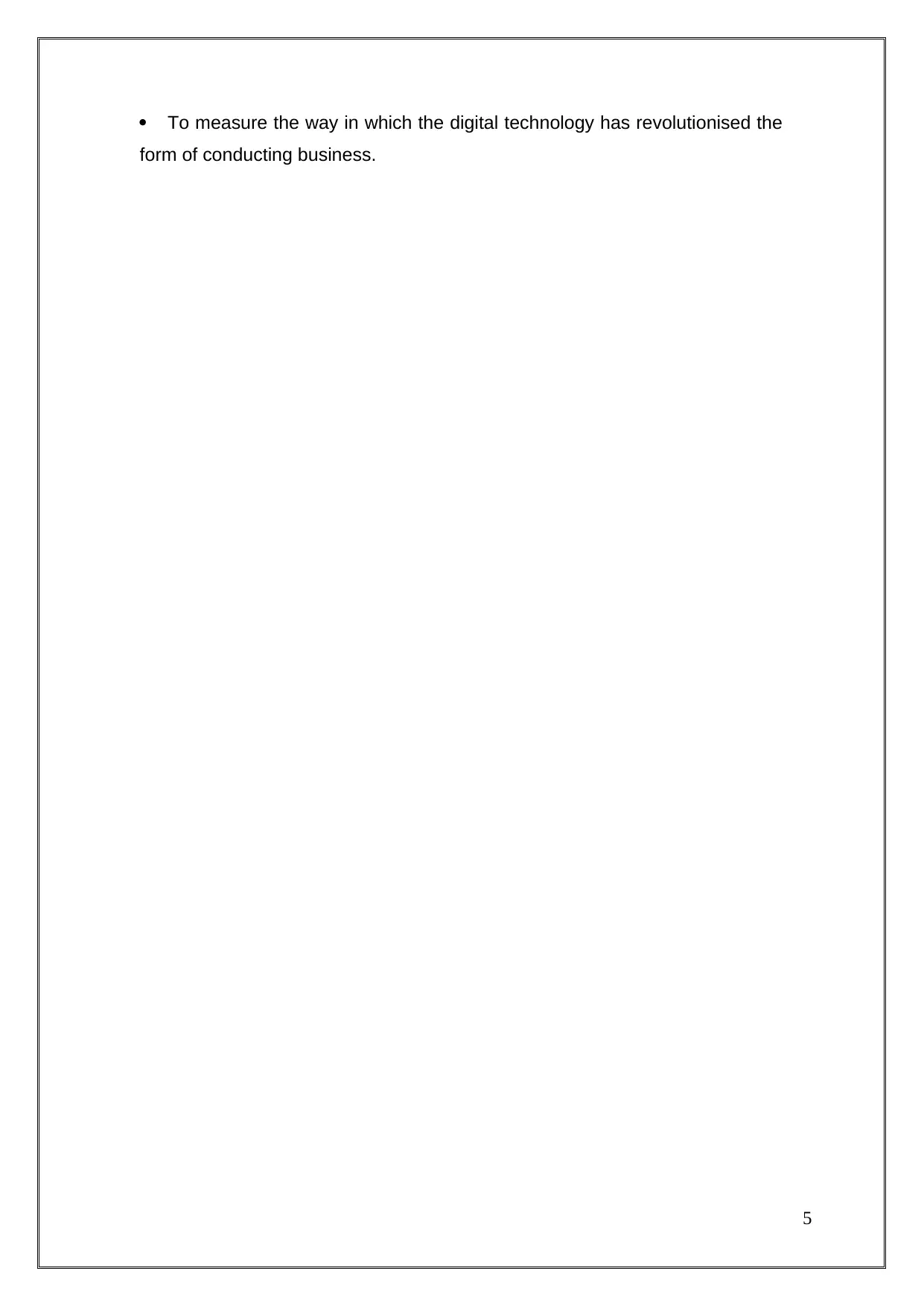
To measure the way in which the digital technology has revolutionised the
form of conducting business.
5
form of conducting business.
5

P2). Produce a project management plan incorporating: costs, scope, time,
quality, communication, risk and resources.
The project management plan consists of various skills, knowledge, techniques, and
tools which is aimed at meeting the needs and requirements of stakeholders. For
carrying out of a project it is essential to have the incorporating of various elements
which are specified below. The list of such elements is as follows (Robichaud and
Anantatmula, 2011):
Costs–The cost refers to the amount which is incurred during the project study. It
includes both the direct and indirect cost. The estimated cost for the respective
project study amounts to €10 million. The cost includes all the expenses incurred in
managing of human resource, physical and financial resources so that results can be
obtained accurate and reliable.
Scope–The concept of digital technology is very wide and many of the businesses at
the international level are making use of modern tool and techniques which lead to
having a great scope of this project. It is not only confined to a particular economy
only but has a large scope and significance.
Time- The time refers to as the element which specifies the time required for
completing a project study. The estimated time required for the project study is
nearly 20 days which is approximately a sufficient time to complete a research.
Quality- The project requires quality of outcome or result as per planned. The quality
here refers to as the evidence and proof required for analysing the impact of digital
technology on the business activities.
Communication–The communication is an essential element for managing a
successful business. There must be a well-defined communication should be
established in the project manager and its team members (Wysocki, 2011).
6
quality, communication, risk and resources.
The project management plan consists of various skills, knowledge, techniques, and
tools which is aimed at meeting the needs and requirements of stakeholders. For
carrying out of a project it is essential to have the incorporating of various elements
which are specified below. The list of such elements is as follows (Robichaud and
Anantatmula, 2011):
Costs–The cost refers to the amount which is incurred during the project study. It
includes both the direct and indirect cost. The estimated cost for the respective
project study amounts to €10 million. The cost includes all the expenses incurred in
managing of human resource, physical and financial resources so that results can be
obtained accurate and reliable.
Scope–The concept of digital technology is very wide and many of the businesses at
the international level are making use of modern tool and techniques which lead to
having a great scope of this project. It is not only confined to a particular economy
only but has a large scope and significance.
Time- The time refers to as the element which specifies the time required for
completing a project study. The estimated time required for the project study is
nearly 20 days which is approximately a sufficient time to complete a research.
Quality- The project requires quality of outcome or result as per planned. The quality
here refers to as the evidence and proof required for analysing the impact of digital
technology on the business activities.
Communication–The communication is an essential element for managing a
successful business. There must be a well-defined communication should be
established in the project manager and its team members (Wysocki, 2011).
6
⊘ This is a preview!⊘
Do you want full access?
Subscribe today to unlock all pages.

Trusted by 1+ million students worldwide
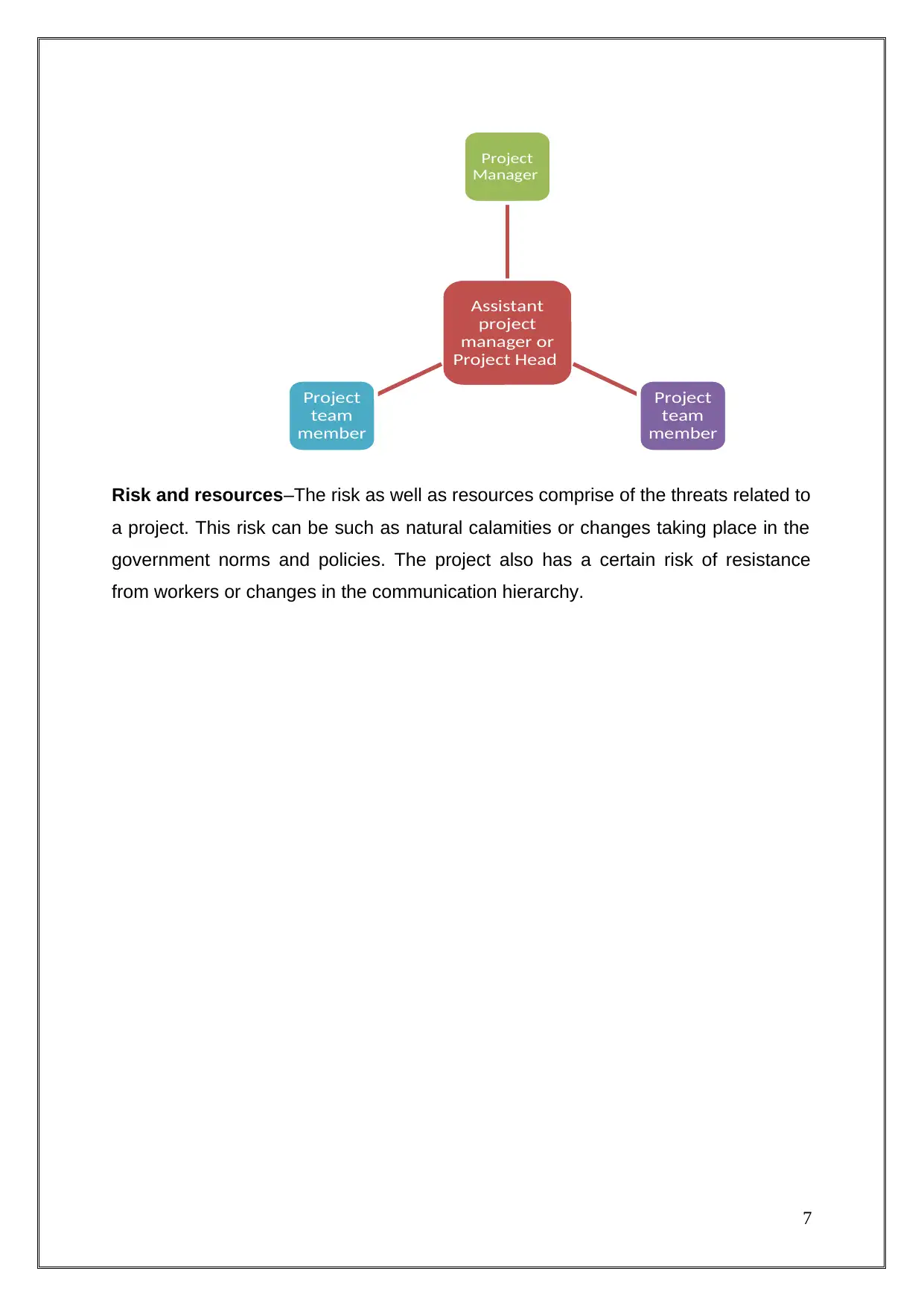
Risk and resources–The risk as well as resources comprise of the threats related to
a project. This risk can be such as natural calamities or changes taking place in the
government norms and policies. The project also has a certain risk of resistance
from workers or changes in the communication hierarchy.
7
Assistant
project
manager or
Project Head
Project
Manager
Project
team
member
Project
team
member
a project. This risk can be such as natural calamities or changes taking place in the
government norms and policies. The project also has a certain risk of resistance
from workers or changes in the communication hierarchy.
7
Assistant
project
manager or
Project Head
Project
Manager
Project
team
member
Project
team
member
Paraphrase This Document
Need a fresh take? Get an instant paraphrase of this document with our AI Paraphraser
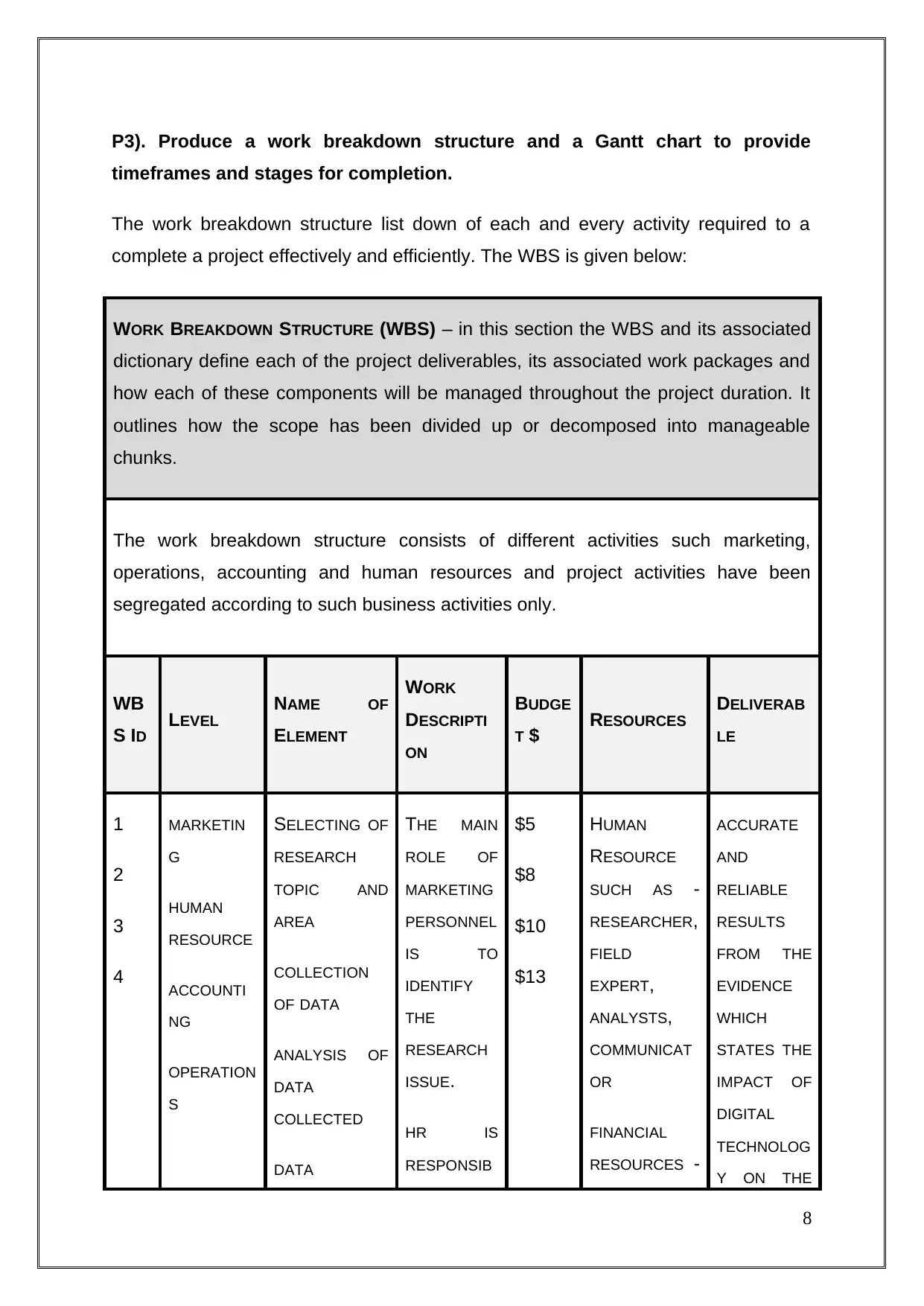
P3). Produce a work breakdown structure and a Gantt chart to provide
timeframes and stages for completion.
The work breakdown structure list down of each and every activity required to a
complete a project effectively and efficiently. The WBS is given below:
WORK BREAKDOWN STRUCTURE (WBS) – in this section the WBS and its associated
dictionary define each of the project deliverables, its associated work packages and
how each of these components will be managed throughout the project duration. It
outlines how the scope has been divided up or decomposed into manageable
chunks.
The work breakdown structure consists of different activities such marketing,
operations, accounting and human resources and project activities have been
segregated according to such business activities only.
WB
S ID
LEVEL
NAME OF
ELEMENT
WORK
DESCRIPTI
ON
BUDGE
T $ RESOURCES
DELIVERAB
LE
1
2
3
4
MARKETIN
G
HUMAN
RESOURCE
ACCOUNTI
NG
OPERATION
S
SELECTING OF
RESEARCH
TOPIC AND
AREA
COLLECTION
OF DATA
ANALYSIS OF
DATA
COLLECTED
DATA
THE MAIN
ROLE OF
MARKETING
PERSONNEL
IS TO
IDENTIFY
THE
RESEARCH
ISSUE.
HR IS
RESPONSIB
$5
$8
$10
$13
HUMAN
RESOURCE
SUCH AS -
RESEARCHER,
FIELD
EXPERT,
ANALYSTS,
COMMUNICAT
OR
FINANCIAL
RESOURCES -
ACCURATE
AND
RELIABLE
RESULTS
FROM THE
EVIDENCE
WHICH
STATES THE
IMPACT OF
DIGITAL
TECHNOLOG
Y ON THE
8
timeframes and stages for completion.
The work breakdown structure list down of each and every activity required to a
complete a project effectively and efficiently. The WBS is given below:
WORK BREAKDOWN STRUCTURE (WBS) – in this section the WBS and its associated
dictionary define each of the project deliverables, its associated work packages and
how each of these components will be managed throughout the project duration. It
outlines how the scope has been divided up or decomposed into manageable
chunks.
The work breakdown structure consists of different activities such marketing,
operations, accounting and human resources and project activities have been
segregated according to such business activities only.
WB
S ID
LEVEL
NAME OF
ELEMENT
WORK
DESCRIPTI
ON
BUDGE
T $ RESOURCES
DELIVERAB
LE
1
2
3
4
MARKETIN
G
HUMAN
RESOURCE
ACCOUNTI
NG
OPERATION
S
SELECTING OF
RESEARCH
TOPIC AND
AREA
COLLECTION
OF DATA
ANALYSIS OF
DATA
COLLECTED
DATA
THE MAIN
ROLE OF
MARKETING
PERSONNEL
IS TO
IDENTIFY
THE
RESEARCH
ISSUE.
HR IS
RESPONSIB
$5
$8
$10
$13
HUMAN
RESOURCE
SUCH AS -
RESEARCHER,
FIELD
EXPERT,
ANALYSTS,
COMMUNICAT
OR
FINANCIAL
RESOURCES -
ACCURATE
AND
RELIABLE
RESULTS
FROM THE
EVIDENCE
WHICH
STATES THE
IMPACT OF
DIGITAL
TECHNOLOG
Y ON THE
8
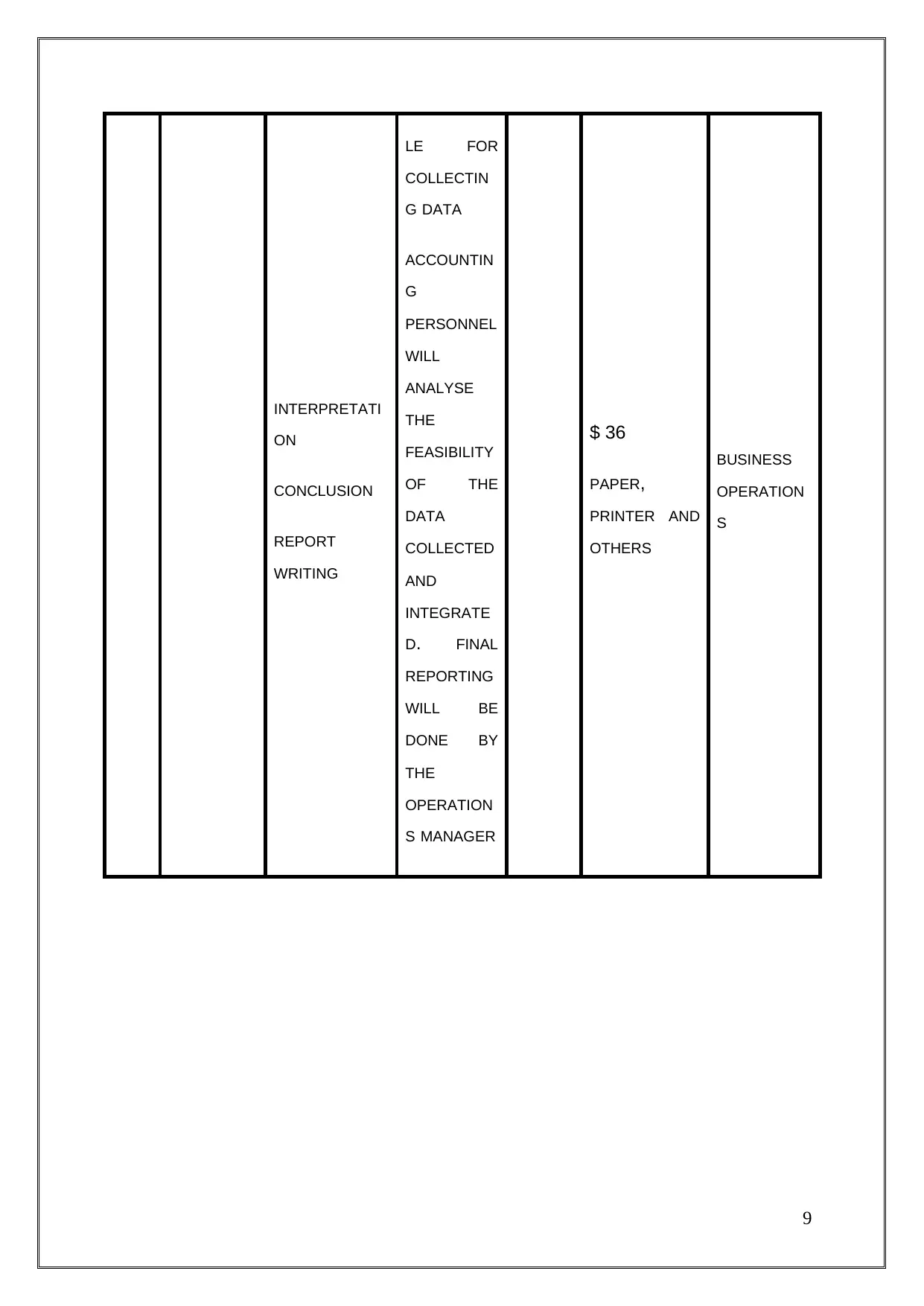
INTERPRETATI
ON
CONCLUSION
REPORT
WRITING
LE FOR
COLLECTIN
G DATA
ACCOUNTIN
G
PERSONNEL
WILL
ANALYSE
THE
FEASIBILITY
OF THE
DATA
COLLECTED
AND
INTEGRATE
D. FINAL
REPORTING
WILL BE
DONE BY
THE
OPERATION
S MANAGER
$ 36
PAPER,
PRINTER AND
OTHERS
BUSINESS
OPERATION
S
9
ON
CONCLUSION
REPORT
WRITING
LE FOR
COLLECTIN
G DATA
ACCOUNTIN
G
PERSONNEL
WILL
ANALYSE
THE
FEASIBILITY
OF THE
DATA
COLLECTED
AND
INTEGRATE
D. FINAL
REPORTING
WILL BE
DONE BY
THE
OPERATION
S MANAGER
$ 36
PAPER,
PRINTER AND
OTHERS
BUSINESS
OPERATION
S
9
⊘ This is a preview!⊘
Do you want full access?
Subscribe today to unlock all pages.

Trusted by 1+ million students worldwide

Gantt chart
The below figure shows the tabular or graphical representation of the work breaks
down structure which is as follows:
Seri
al
No. Project Activities Time Period
1 2 3 4 5 6 7 8 9
1
0
1
1
1
2
1
3
1
4
1
5
1
6
1
7
1
8
1
9
2
0
1
SELECTING OF
RESEARCH TOPIC
AND AREA
2
COLLECTION OF
DATA
3
ANALYSIS OF DATA
COLLECTED
4
DATA
INTERPRETATION
5 Conclusion
6 Report Writing
10
The below figure shows the tabular or graphical representation of the work breaks
down structure which is as follows:
Seri
al
No. Project Activities Time Period
1 2 3 4 5 6 7 8 9
1
0
1
1
1
2
1
3
1
4
1
5
1
6
1
7
1
8
1
9
2
0
1
SELECTING OF
RESEARCH TOPIC
AND AREA
2
COLLECTION OF
DATA
3
ANALYSIS OF DATA
COLLECTED
4
DATA
INTERPRETATION
5 Conclusion
6 Report Writing
10
Paraphrase This Document
Need a fresh take? Get an instant paraphrase of this document with our AI Paraphraser
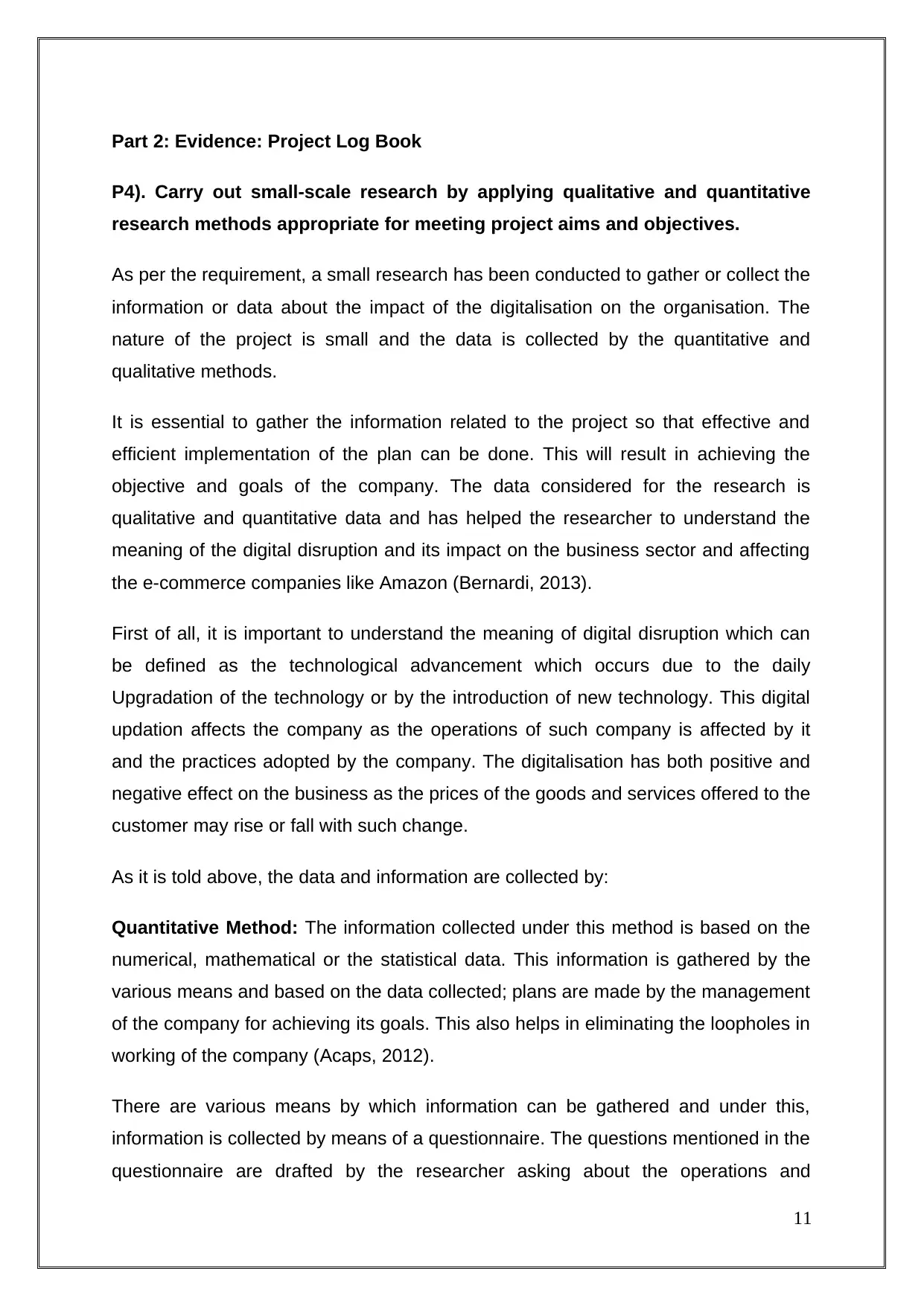
Part 2: Evidence: Project Log Book
P4). Carry out small-scale research by applying qualitative and quantitative
research methods appropriate for meeting project aims and objectives.
As per the requirement, a small research has been conducted to gather or collect the
information or data about the impact of the digitalisation on the organisation. The
nature of the project is small and the data is collected by the quantitative and
qualitative methods.
It is essential to gather the information related to the project so that effective and
efficient implementation of the plan can be done. This will result in achieving the
objective and goals of the company. The data considered for the research is
qualitative and quantitative data and has helped the researcher to understand the
meaning of the digital disruption and its impact on the business sector and affecting
the e-commerce companies like Amazon (Bernardi, 2013).
First of all, it is important to understand the meaning of digital disruption which can
be defined as the technological advancement which occurs due to the daily
Upgradation of the technology or by the introduction of new technology. This digital
updation affects the company as the operations of such company is affected by it
and the practices adopted by the company. The digitalisation has both positive and
negative effect on the business as the prices of the goods and services offered to the
customer may rise or fall with such change.
As it is told above, the data and information are collected by:
Quantitative Method: The information collected under this method is based on the
numerical, mathematical or the statistical data. This information is gathered by the
various means and based on the data collected; plans are made by the management
of the company for achieving its goals. This also helps in eliminating the loopholes in
working of the company (Acaps, 2012).
There are various means by which information can be gathered and under this,
information is collected by means of a questionnaire. The questions mentioned in the
questionnaire are drafted by the researcher asking about the operations and
11
P4). Carry out small-scale research by applying qualitative and quantitative
research methods appropriate for meeting project aims and objectives.
As per the requirement, a small research has been conducted to gather or collect the
information or data about the impact of the digitalisation on the organisation. The
nature of the project is small and the data is collected by the quantitative and
qualitative methods.
It is essential to gather the information related to the project so that effective and
efficient implementation of the plan can be done. This will result in achieving the
objective and goals of the company. The data considered for the research is
qualitative and quantitative data and has helped the researcher to understand the
meaning of the digital disruption and its impact on the business sector and affecting
the e-commerce companies like Amazon (Bernardi, 2013).
First of all, it is important to understand the meaning of digital disruption which can
be defined as the technological advancement which occurs due to the daily
Upgradation of the technology or by the introduction of new technology. This digital
updation affects the company as the operations of such company is affected by it
and the practices adopted by the company. The digitalisation has both positive and
negative effect on the business as the prices of the goods and services offered to the
customer may rise or fall with such change.
As it is told above, the data and information are collected by:
Quantitative Method: The information collected under this method is based on the
numerical, mathematical or the statistical data. This information is gathered by the
various means and based on the data collected; plans are made by the management
of the company for achieving its goals. This also helps in eliminating the loopholes in
working of the company (Acaps, 2012).
There are various means by which information can be gathered and under this,
information is collected by means of a questionnaire. The questions mentioned in the
questionnaire are drafted by the researcher asking about the operations and
11
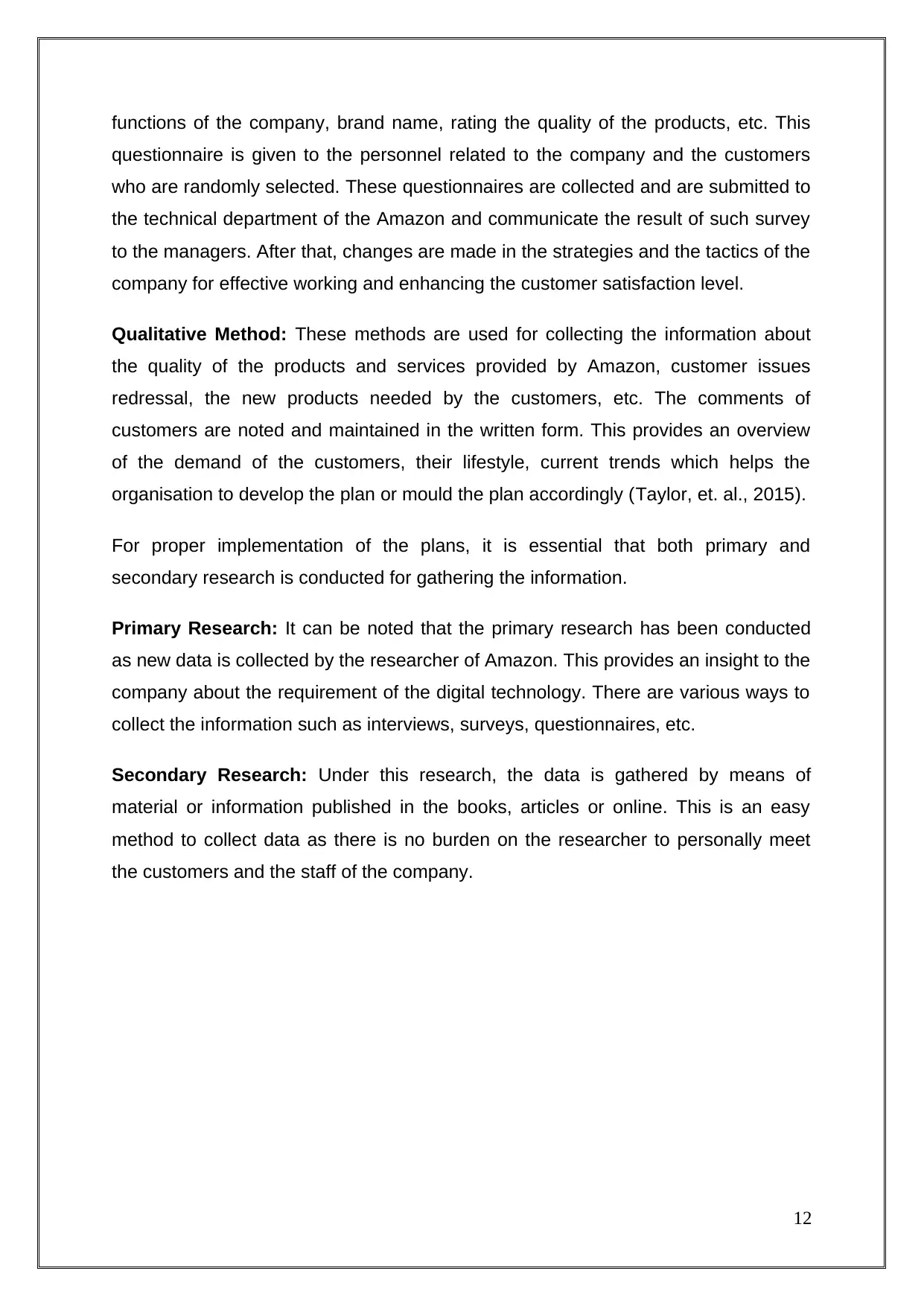
functions of the company, brand name, rating the quality of the products, etc. This
questionnaire is given to the personnel related to the company and the customers
who are randomly selected. These questionnaires are collected and are submitted to
the technical department of the Amazon and communicate the result of such survey
to the managers. After that, changes are made in the strategies and the tactics of the
company for effective working and enhancing the customer satisfaction level.
Qualitative Method: These methods are used for collecting the information about
the quality of the products and services provided by Amazon, customer issues
redressal, the new products needed by the customers, etc. The comments of
customers are noted and maintained in the written form. This provides an overview
of the demand of the customers, their lifestyle, current trends which helps the
organisation to develop the plan or mould the plan accordingly (Taylor, et. al., 2015).
For proper implementation of the plans, it is essential that both primary and
secondary research is conducted for gathering the information.
Primary Research: It can be noted that the primary research has been conducted
as new data is collected by the researcher of Amazon. This provides an insight to the
company about the requirement of the digital technology. There are various ways to
collect the information such as interviews, surveys, questionnaires, etc.
Secondary Research: Under this research, the data is gathered by means of
material or information published in the books, articles or online. This is an easy
method to collect data as there is no burden on the researcher to personally meet
the customers and the staff of the company.
12
questionnaire is given to the personnel related to the company and the customers
who are randomly selected. These questionnaires are collected and are submitted to
the technical department of the Amazon and communicate the result of such survey
to the managers. After that, changes are made in the strategies and the tactics of the
company for effective working and enhancing the customer satisfaction level.
Qualitative Method: These methods are used for collecting the information about
the quality of the products and services provided by Amazon, customer issues
redressal, the new products needed by the customers, etc. The comments of
customers are noted and maintained in the written form. This provides an overview
of the demand of the customers, their lifestyle, current trends which helps the
organisation to develop the plan or mould the plan accordingly (Taylor, et. al., 2015).
For proper implementation of the plans, it is essential that both primary and
secondary research is conducted for gathering the information.
Primary Research: It can be noted that the primary research has been conducted
as new data is collected by the researcher of Amazon. This provides an insight to the
company about the requirement of the digital technology. There are various ways to
collect the information such as interviews, surveys, questionnaires, etc.
Secondary Research: Under this research, the data is gathered by means of
material or information published in the books, articles or online. This is an easy
method to collect data as there is no burden on the researcher to personally meet
the customers and the staff of the company.
12
⊘ This is a preview!⊘
Do you want full access?
Subscribe today to unlock all pages.

Trusted by 1+ million students worldwide
1 out of 31
Related Documents
Your All-in-One AI-Powered Toolkit for Academic Success.
+13062052269
info@desklib.com
Available 24*7 on WhatsApp / Email
![[object Object]](/_next/static/media/star-bottom.7253800d.svg)
Unlock your academic potential
Copyright © 2020–2025 A2Z Services. All Rights Reserved. Developed and managed by ZUCOL.




